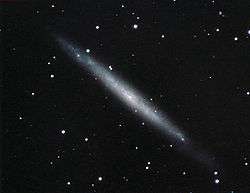Central massive object
|
The star-like nucleus at the center of this edge-on spiral galaxy, NGC 4244, is a central massive object. | |
Central massive object (CMO) refers to a mass concentration at the center of a galaxy. It can be either a supermassive black hole or a nuclear star cluster, i.e. a dense cluster of stars.
The most massive galaxies are thought to always contain a supermassive black hole (SBH); these galaxies do not contain nuclear star clusters, and the CMO is identified with the SBH. Fainter galaxies usually contain a nuclear star cluster (NSC). in most of these galaxies it is not known whether a supermassive black hole is present, and the CMO is identified with the NSC.[1] A few galaxies, for instance the Milky Way and NGC 4395, are known to contain both a SBH and a NSC.
The mass associated with CMOs is roughly 0.1–0.3% times the total mass of the galactic bulge.[1]
See also
References
- 1 2 Merritt, David (2013). Dynamics and Evolution of Galactic Nuclei. Princeton, NJ: Princeton University Press.
